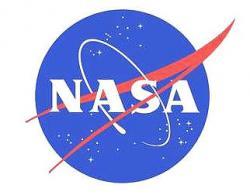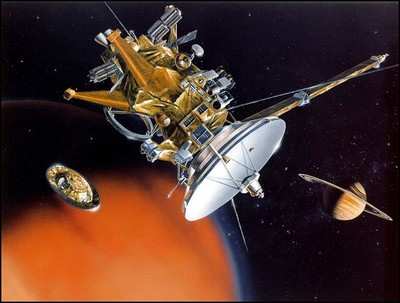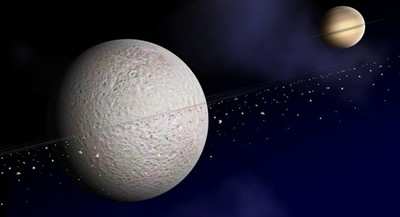 NASA's Cassini spacecraft has found
evidence of material orbiting Rhea, Saturn's second largest moon.
This is the first time rings may have been found around a moon. A
broad debris disk and at least one ring appear to have been
detected by a suite of six instruments on Cassini specifically
designed to study the atmospheres and particles around Saturn and
its moons.
NASA's Cassini spacecraft has found
evidence of material orbiting Rhea, Saturn's second largest moon.
This is the first time rings may have been found around a moon. A
broad debris disk and at least one ring appear to have been
detected by a suite of six instruments on Cassini specifically
designed to study the atmospheres and particles around Saturn and
its moons.
"Until now, only planets were known to have rings, but now Rhea
seems to have some family ties to its ringed parent Saturn," said
Geraint Jones, a Cassini scientist and lead author on a paper that
appears in the March 7 issue of the journal Science. Jones began
this work while at the Max Planck Institute for Solar System
Research, Katlenburg-Lindau, Germany, and is now at the Mullard
Space Science Laboratory, University College, London.
Rhea is roughly 1,500 kilometers (950 miles) in diameter. The
apparent debris disk measures several thousand miles from end to
end. The particles that make up the disk and any embedded rings
probably range from the size of small pebbles to boulders. An
additional dust cloud may extend up to 5,900 kilometers (3,000
miles) from the moon's center, almost eight times the radius of
Rhea.
"Like finding planets around other stars, and moons around
asteroids, these findings are opening a new field of rings around
moons," said Norbert Krupp, a scientist with Cassini's
Magnetospheric Imaging Instrument from the Max Planck Institute for
Solar System Research.
Since the discovery, Cassini scientists have carried out
numerical simulations to determine if Rhea can maintain rings. The
models show that Rhea's gravity field, in combination with its
orbit around Saturn, could allow rings that form to remain in place
for a very long time.

The discovery was a result of a Cassini close flyby of Rhea in
November 2005, when instruments on the spacecraft observed the
environment around the moon. Three instruments sampled dust
directly. The existence of some debris was expected because a rain
of dust constantly hits Saturn's moons, including Rhea, knocking
particles into space around them. Other instruments' observations
showed how the moon was interacting with Saturn's magnetosphere,
and ruled out the possibility of an atmosphere.
Evidence for a debris disk in addition to this tenuous dust
cloud came from a gradual drop on either side of Rhea in the number
of electrons detected by two of Cassini's instruments. Material
near Rhea appeared to be shielding Cassini from the usual rain of
electrons. Cassini's Magnetospheric Imaging Instrument detected
sharp, brief drops in electrons on both sides of the moon,
suggesting the presence of rings within the disk of debris. The
rings of Uranus were found in a similar fashion, by NASA's Kuiper
Airborne Observatory in 1977, when light from a star blinked on and
off as it passed behind Uranus' rings.
"Seeing almost the same signatures on either side of Rhea was
the clincher," added Jones. "After ruling out many other
possibilities, we said these are most likely rings. No one was
expecting rings around a moon."
One possible explanation for these rings is that they are
remnants from an asteroid or comet collision in Rhea's distant
past. Such a collision may have pitched large quantities of gas and
solid particles around Rhea. Once the gas dissipated, all that
remained were the ring particles. Other moons of Saturn, such as
Mimas, show evidence of a catastrophic collision that almost tore
the moon apart.
"The diversity in our solar system never fails to amaze us,"
said Candy Hansen, co-author and Cassini scientist on the
Ultraviolet Imaging Spectrograph at NASA's Jet Propulsion
Laboratory, Pasadena, Calif. "Many years ago we thought Saturn was
the only planet with rings. Now we may have a moon of Saturn that
is a miniature version of its even more elaborately decorated
parent."
These ring findings make Rhea a prime candidate for further
study. Initial observations by the imaging team when Rhea was near
the sun in the sky did not detect dust near the moon remotely.
Additional observations are planned to look for the larger
particles.

The Cassini-Huygens mission is a cooperative project of NASA,
the European Space Agency and the Italian Space Agency. JPL, a
division of the California Institute of Technology in Pasadena,
manages the Cassini-Huygens mission for NASA's Science Mission
Directorate, Washington. The Cassini orbiter was designed,
developed and assembled at JPL. The Magnetospheric Imaging
Instrument was designed, built and is operated by an international
team led by the Applied Physics Laboratory of the Johns Hopkins
University, Laurel, Md.
 ANN's Daily Aero-Linx (05.06.25)
ANN's Daily Aero-Linx (05.06.25) ANN's Daily Aero-Term (05.06.25): Ultrahigh Frequency (UHF)
ANN's Daily Aero-Term (05.06.25): Ultrahigh Frequency (UHF) ANN FAQ: Q&A 101
ANN FAQ: Q&A 101 Classic Aero-TV: Virtual Reality Painting--PPG Leverages Technology for Training
Classic Aero-TV: Virtual Reality Painting--PPG Leverages Technology for Training Airborne 05.02.25: Joby Crewed Milestone, Diamond Club, Canadian Pilot Insurance
Airborne 05.02.25: Joby Crewed Milestone, Diamond Club, Canadian Pilot Insurance





